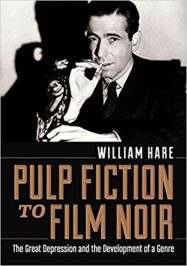With the advent of the Great Depression, Hollywood discovered new characters and fresh labels of films that displayed the effects of the economic struggle on various types of individuals, be it the small-time crook, the innocent and wrongly accused businessman, the farmer or the simple secretary. All of them had to face new obstacles in their way of life. But now it was even harder – it seemed – to find trustworthy allies, friends, civil servants or employees than before.
 Some of the earliest examples of successful crime films of the 1940s – later labeled Film Noir – were based on novels and short stories by American writers of so called “pulp fiction,” among them James M. Cain, Horace McCoy, Cornell Woolrich, Dashiell Hammett and Raymond Chandler.
Some of the earliest examples of successful crime films of the 1940s – later labeled Film Noir – were based on novels and short stories by American writers of so called “pulp fiction,” among them James M. Cain, Horace McCoy, Cornell Woolrich, Dashiell Hammett and Raymond Chandler.
It is on the work of the latter two (famous contributors to legendary pulp fiction magazine Black Mask) that the book puts emphasis and here William Hare does a great job, namely cover the collaboration of the two authors concerning film versions of their own novels and stories. And their involvement with scripts turned into successful movies by directors such as Alfred Hitchcock, Billy Wilder and Sidney Pollack.
Since readers and film audiences did not necessarily share the same aesthetic language, sometimes the film adaption needed shortening or editing. But generally, the 1940s crime and mystery film stories did not necessarily need to be entirely explained; sometimes it was intended that the victims (and sometimes even the villains) remained completely in the dark. So did the audience, meaning that by keeping the story interesting and well manned by good actors, a remarkable movie usually was the product.
For that was another trademark of those times: the individual could not rely upon experience or former personal bonds anymore. Accordingly, circumstances and situations in reality, and everyday life, inexplicable and mysterious some years before the Great Depression, were now rather accepted than scrutinized. Times were strange, but people tried to make the best out of it without asking too many questions.
With as much detail as film historian William Hare devotes to Hammet, Chandler and perfect Film Noir actor Humphrey Bogart, the reader would expect to find the same amount of rich anecdotes and background information in the latter parts of the book.
Unfortunately, the chapters on Vienna’s and Berlin’s variation of Film Noir and the role of the outsider are promising but could be somewhat more circumstantial and so the last highlight of the book is Hare’s chapter on “Siodmak’s Phantom Femmes.”
Actually, the book – although not an academic publication – may have left a better impression if it could have fulfilled the promise of its title, namely to show and analyze the development of pulp fiction into Film Noir. But by devoting most chapters to just a few authors and directors, the book leaves unanswered many questions concerning other contemporary writers of pulp fiction.
Review by Dr. A. Ebert (c) 2013
William Hare. Pulp Fiction to Film Noir. The Great Depression and the Development of a Genre. McFarland, 2012, 222 p.
